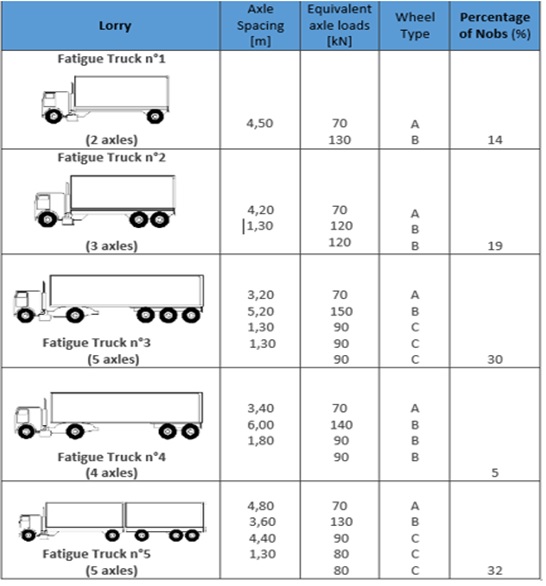Charles Bwemba
National Advanced School of Public Works (ENSTP), Cameroon
Emanuele Maiorana
Isolcomit Srl, Legnaro, Italy
Steve Loic Michel Modi
National Advanced School of Public Works (ENSTP), Cameroon
I ponti stradali compositi sono solitamente soggetti ad azioni dinamiche e, a seconda dell’intensità dei cicli di carico, ciò può compromettere l’affidabilità della risposta del sistema strutturale che potrebbe anche portare ad una riduzione della vita utile prevista del ponte. In questo lavoro viene studiata la fatica dovuta ai carichi di traffico e alle sollecitazioni sul sistema strutturale di un ponte composito acciaio-calcestruzzo. In primo luogo, è stata effettuata una valutazione teorica seguendo le norme Eurocodice e AASHTO per il calcolo delle sollecitazioni nominali. Il modello 3D del ponte è stato quindi sviluppato utilizzando il software CSi Bridge di Finite Element Analysis per la valutazione della storia di carico e calibrato mediante calcoli manuali utilizzando le linee di influenza. Sono state utilizzate le curve di Wöhler per valutare la resistenza alla fatica di dettagli critici come la saldatura di testa, con lunetta di scarico e degli irrigidimenti verticali, per la valutazione della domanda di capacità a seguito della registrazione del traffico (carichi ciclici) sul ponte composito acciaio-calcestruzzo a una campata. Per calcolare il danno cumulato è stato utilizzato il metodo di accumulo sui dettagli critici secondo gli Eurocodici. Seguendo l’AASHTO, la sollecitazione massima è stata calcolata dalla sollecitazione equivalente, risultato di un’accurata analisi, utilizzando gli intervalli di sollecitazione di ampiezza variabile del rilevamento del camion nella posizione di dettaglio critica. La sollecitazione massima è stata confrontata con la soglia di fatica ad ampiezza costante per la valutazione della vita infinita. Infine, la vita residua del sistema strutturale del ponte è stata prevista secondo Eurocodici e AASHTO.
1. Introduction
Fatigue is a progressive deterioration of a structure by crack growth, due to a series of stress variations cycles resulting from the application of repeated loads, such as those induced in bridge components under traffic loads and heavy vehicle crossings. The stress amplitudes are much lower than the failure strength of the material and are experienced very often or even continuously during the structures lifetime. Fatigue damage is a function of the magnitude and frequency of load effect cycles, as well as of the fatigue strength or behaviour of a structural detail [1]. Fatigue is the first cause of bridge damage [2].  Depending on the intensity and cycles of these dynamic actions, these adverse effects may compromise the structural system response reliability that could also lead to a reduction of the expected bridge service life [3]. The fatigue life of a member is the number of load cycles the member can endure before, confronting the structures serviceability limit state. Within a structures fatigue life, the structure is considered to experience deterioration in two different steps: crack initiation and crack propagation. The crack initiation period describes the time when cracks are just beginning to initiate from points of stress concentrations in structural details. Once a fatigue crack has initiated, applied repeated stresses cause propagation, or growth, of a crack across the section until the member is capable of fracture, also considered the end of fatigue life [4]. It is well known that metals will break down under repeated application, and especially under repeated reversal of stresses, greatly less than those that have to be applied when the ultimate strength of a material is tested in the ordinary way [5]. On average, the life expectancy of highway bridges is anywhere between 75 and 100 years. The service life of a bridge will depend on the weight and frequency of vehicle passing over, exposure to adverse conditions, and the regularity of check-ups or maintenance conducted on the bridge [6]. Unaltered rolled shape or plate presents the most favourable fatigue life situation. However, there are not many practical cases in which a rolled shape or plate does not have some kind of attachment, connection, or other alteration. A simple built-up section is composed of several steel plates joined together by welding. These details have fatigue resistance less than the unaltered shape or plate. Most specifications have adopted a fatigue life estimation for welded details that is dependent solely upon the stress range and detail connection, see [7-29].[…]
Depending on the intensity and cycles of these dynamic actions, these adverse effects may compromise the structural system response reliability that could also lead to a reduction of the expected bridge service life [3]. The fatigue life of a member is the number of load cycles the member can endure before, confronting the structures serviceability limit state. Within a structures fatigue life, the structure is considered to experience deterioration in two different steps: crack initiation and crack propagation. The crack initiation period describes the time when cracks are just beginning to initiate from points of stress concentrations in structural details. Once a fatigue crack has initiated, applied repeated stresses cause propagation, or growth, of a crack across the section until the member is capable of fracture, also considered the end of fatigue life [4]. It is well known that metals will break down under repeated application, and especially under repeated reversal of stresses, greatly less than those that have to be applied when the ultimate strength of a material is tested in the ordinary way [5]. On average, the life expectancy of highway bridges is anywhere between 75 and 100 years. The service life of a bridge will depend on the weight and frequency of vehicle passing over, exposure to adverse conditions, and the regularity of check-ups or maintenance conducted on the bridge [6]. Unaltered rolled shape or plate presents the most favourable fatigue life situation. However, there are not many practical cases in which a rolled shape or plate does not have some kind of attachment, connection, or other alteration. A simple built-up section is composed of several steel plates joined together by welding. These details have fatigue resistance less than the unaltered shape or plate. Most specifications have adopted a fatigue life estimation for welded details that is dependent solely upon the stress range and detail connection, see [7-29].[…]
Leggi l’articolo completo su Costruzioni Metalliche, n. 5/2022.

